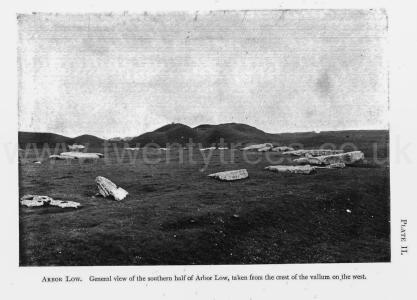Europe, British Isles, England, South Yorkshire, Sheffield, Weston Park Museum
Thomas Bateman 1845. On the 21st of May, 1845, was opened a barrow called Carder Lowe [Map], near Hartington, which is about fourteen yards in diameter, and, owing to the former removal of its summit, is not more than two feet in average elevation. In the process of excavation about eighty quartz pebbles and several instruments of flint were found, amongst the latter a very neatly-formed barbed arrow-head. These articles were possibly cast into the mound during its construction by mourners and friends of the deceased, as tokens of respect. In addition to these were a few pieces of a coarse urn, curiously ornamented.
About the centre was found the skeleton of the chiefs over whom the barrow had been at first raised. He lay upon the right side, with the head towards the east, and the legs contracted very slightly; at his elbow lay a splendid brass or bronze dagger, in a good state of preservation. It has three large rivets remaining, which had securely attached the handle, which was still easily traceable by the wood of which it had been composed having decayed into a black mould, which contrasted strongly with the light-coloured, clayey soil in which the body was imbedded. A few inches lower down was placed a beautiful axe- or hammer-head of light-coloured basalt of much smaller size than usual, and which was originally nicely polished. Close to the head was found a small piece of calcined flint, of no apparent design or form. The skeleton was surrounded with rats' bones, the undoubted remains of those four-footed cannibals who had preyed upon the body, and had endeavoured to devour the bones of this ancient British chief, many of the latter were half-eaten away. Rather nearer to the south side of the barrow, and on a higher level, another interment was discovered, which consisted of a skeleton of mighty size, the femur or thigh-bone measuring twenty-three inches in length, which would give a height to the owner, when alive, of six feet, eight or ten inches. Along with this lengthy individual, an iron knife and three hones of sandstone were deposited; also a few pieces of calcined bone. This was evidently a secondary interment, of later date than the one previously described, which was undoubtedly the original one.
Note. The bronze dagger on display at Weston Park Museum, Sheffield.

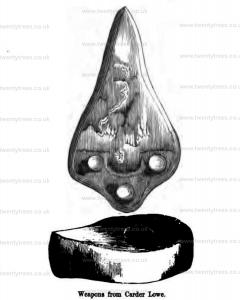
Thomas Bateman 1846. On the 12th of August 1846, was opened a low flat barrow at Windle (Wind Lowe) Nook [Map], near Hargate Wall, Derbyshire, about twenty yards in diameter, two feet high, and encircled by a ring of large flat limestones, placed in a sloping manner on one side, about three yards from the margin of the tumulus, apparently for the purpose of preserving its symmetry. The top of this barrow is surmounted by a large square sandstone, which has originally formed the base of one of the wayside crosses, of which numerous examples remain in the north of Derbyshire. About the centre of the barrow was a cist, measuring near six feet by four, in horizontal area, and three feet in depth, of unusual construction, the sides being built of large stones set on end, some of which appeared above the turf; an examination of the contents of this cist led to the conclusion that it had been applied to sepulchral purposes at various distinct periods, and that the last interment had been partially disturbed at a comparatively recent period; the contents were as follows: small pieces of urn, calcined bones and flints, skeletons of two persons of full stature, and of two infants, one of them very young, and various animal bones, amongst which, those of the rat, weasel, and horse were most conspicuous. All these articles were so much out of their ordinary arrangement, as to leave no doubt of their disinterment at the time of the burial of another skeleton, which lay in a contracted position a few inches above the floor of the vault; this skeleton, which, from the ornaments discovered with it, and the slender proportions of the bones, must be attributed to a female, had not entirely escaped spoliation at a recent period; the following circumstances seem to put this question beyond doubt, namely, the discovery of sundry pieces of tobacco-pipe, and nails from rustics' shoes, and from the fact of finding part of a very large ivory pin, and a fragment of an armilla or bracelet of Kimmeridge coal, both of which would undoubtedly have been perfect at the time they were deposited. Whoever these former excavators were, they were not very close observers as they had overlooked a necklace of beads of the aforesaid Kimmeridge coal, terminated by two perforated conical studs of the same, and enriched by six pieces of ivory, ornamented with the everlasting chevron or zig-zag pattern so universally prevalent on Celtic remains. The beads, exclusive of the studs and ornaments, are seventy-six in number, and are identical with two that are figured in plate 3, vol. i of Sir. Richard Hoare's excellent work. The ivory ornaments are quite novel, no other example having been published.
Note. The necklace discovered at Wind Low on display at Weston Park Museum, Sheffield.
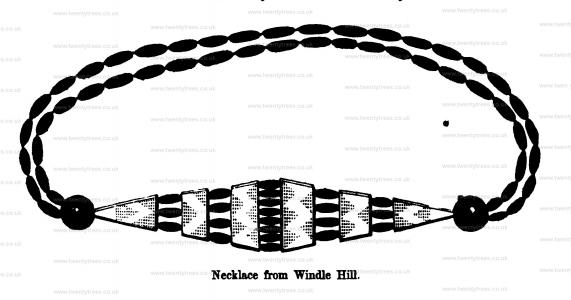

Thomas Bateman 1846. On the 29th of August 1846. The barrow at Cow Lowe [Map], near Buxton, was opened; although a little disturbed on the surface by the operations of stone-getters, the interments were quite intact. The number and importance of these deposits render needful a minute description of most of them, and a chronological arrangement will make each particular much more intelligible; by the latter system, we commence with the presumed primary interment, then tracing each succeeding one, in the order in which it was inhumed, instead of relating the particulars of each, in the rotation in which they were brought to light by the spade. Upon the floor of the barrow, which slightly exceeded the depth of four feet from the summit, was laid apparently the primitive interment, covered over with a large flat stone, but not inclosed in a cist; it was the body of a person of small stature, probably a female, with the knees contracted; it altogether rested upon a layer of calcined human bones, amongst which was found a bone pin, which had been perforated at the thicker end, but now broken, and part of a dog's head, also several horses' teeth; a few inches higher up, the whole of the centre of the tumulus was covered with human bones, unaccompanied by anything worthy of notice, if we except a few pieces of an urn, coarse, both in material and workmanship. The number of jaw-bones belonging to different skeletons in this part of the barrow was five, though it is probable that a greater number of individuals were here interred. About a foot higher than these, and slightly out of the centre of the barrow, was a small cist, made of stones set edgeways, which contained the bones of a female in the usual contracted position, with which were two sets of Kimmeridge coal beads (one hundred and seventeen in number), of very neat workmanship; the central ornaments are in this case made of the same material as the beads, though it will be remembered that, in the similar ornament found at Wind Lowe [Map], the central plates were of bone or ivory; a faintly marked diamond pattern is discernible upon the plates of shale; with these lay a fine instrument of calcined flint, of the circular-ended form; a few of the beads lay on the outside of the cist, where was part of the skeleton of a child, to whom possibly one set of beads might belong, or, what is more probable, that they were disturbed at the time of the construction of the hexagonal cell, which was placed partly upon the cist pertaining to the lady, at a slightly higher level; in it were deposited two skeletons, one above the other, much crushed up in order to accommodate them to the confined limits of the cell; with the lower one was a neatly ornamented urn of unbaked clay, much decayed and broken. The latest and most interesting interment, which may be attributed to the Romano-British period, or perhaps by some antiquaries to the early Saxon era, lay in the centre of the harrow, and about midway between the surface of the natural ground and the top of the former; the bones were mostly decayed, so much indeed, as to leave no trace except the teeth, and a small portion of the cranium; near which, probably about the neck, were two pins of gold, connected by a chain of the same, of remarkably neat design and execution; the heads of the pins contain a setting of many coloured glass, platted upon a chequered gold foil; close to them, and apparently having slipped off the chain, by a large bead of blue glass. The earth for a few feet from this place appeared to have been tempered with water, or puddled, at the time of the funeral, which gave it a very solid and undisturbed appearance; this, coupled with the absence of bones, makes it difficult to decide near what part of body the following articles were originally placed; they were about eighteen inches distant from the pins, which were certainly close to the head. These articles had been inclosed in a wooden box, made of ash plank half an inch in thickness, which was wrapped in a woollen cloth, the warp of which is perfectly visible; the hinges of this casket (two in number) are of brass, and were fastened with brass pins, which were clenched upon a piece of stout leather in the inside of the box; it was fastened by a brass hasp of similar type to the hinges, which received a small staple, to which was hung an iron padlock; it contained a small vessel of thick green glass, an ivory comb much decayed, some instruments of iron, a piece of perforated ivory, apparently the end of some utensil, which was encircled by a brass hoop at the time of its discovery, but which fell to dust on exposure, and a neck decoration of various pensile ornaments, eleven in number; the centre one is of blue porcelain or glass, with three serpents in white; it is retained in a setting of silver, with vandyked edges, on either side of this is a spiral wire bead of electrum, whilst the suit is made up of small circular pendants of silver, extremely thin, each having a level back and a convex front, and each stamped out of a separate piece; of these the number is eight, and with the exception of one, which has a beaded circle running round it, are all struck from the same die, a small flaw being visible on each; the box also contained a dog's or fox's tooth; and a short distance above the body, in the same tempered earth, lay a portion of the horn of the red deer. In various parts of the tumulus, but not in situations where they could be allotted with certainty to any of the interments, were found a scattered deposit of burnt bones, a bead of Kimmeridge coal, of more globular form than the others, much worn, a neat pin of bone, a pointed instrument of the same, apparently a lance-head, and the usual chippings of flint, and rats' bones.
Note. Necklace, possibly, from Cow Low on display at Weston Park Museum, Sheffield.
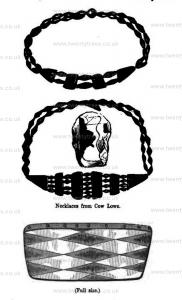


Benty Grange. May 3rd. - It was our good fortune to open a barrow which afforded a more instructive collection of relics than has ever been discovered in the county, and which are not surpassed in interest by any remains hitherto recovered from any Anglo-Saxon burying place in the kingdom.
The barrow [Benty Grange Barrow [Map]], which is on a farm called Benty Grange, a high and bleak situation to the right of the road from Ashbourn to Buxton, near the eighth milestone from the latter place, is of inconsiderable elevation, perhaps not more than two feet at the highest point, but is spread over a pretty large area, and is surrounded by a small fosse or trench. About the centre and upon the natural soil, had been laid the only body the barrow ever contained, of which not a vestige besides the hair could be distinguished. Near the place which, from the presence of hair, was judged to have been the situation of the head, was a curious assemblage of ornaments, which, from the peculiarly indurated nature of the earth, it was impossible to remove with any degree of success. The most remarkable are the silver edging and ornaments of a leathern cup, about three inches diameter at the mouth, which was decorated by four wheel-shaped ornaments and two crosses of thin silver, affixed by pins of the same metal, clenched inside.
The other articles found in the same situation consist of personal ornaments, the chief of which are two circular enamels upon copper 1¾ diameter, in narrow silver frames, and a third, which was so far decomposed as to be irrecoverable; they are enamelled with a yellow interlaced dracontine pattern, intermingled with that peculiar scroll design, visible on the same class of ornaments figured in Vestiges p. 25, and used in several manuscripts of the Vllth Century, for the purpose of decorating the initial letters. The principle of this design consists of three spiral lines springing from a common centre, and each involution forming an additional centre for an extension of the pattern, which may be adapted to fill spaces of almost any form. Mr. Westwood has shown in a most able paper in the 40th No. of the Journal of the Archæological Institute, that this style of ornamentation is peculiar to the Anglo-Saxon and Irish Artists of the period before stated. The pattern was first cut in the metal, threads of it being left to show the design, by which means cells were formed, in which the enamel was placed before fusion, the whole being then polished became what is known as Champ-levé enamel. There was also with these enamels a knot of very fine wire, and a quantity of thin bone variously ornamented with lozenges &c, which was mostly too much decayed to bear removal; it appeared to have been attached to some garment of silk, as the glossy fibre of such a fabric was very perceptible when they were first uncovered, though it shortly vanished when exposed to the air. Proceeding westward from the head for about six feet, we arrived at a large mass of oxidyzed iron, which, being removed with the utmost care, and having been since repaired, were unavoidably broken, now presents a mass of chainwork, and the frame of a helmet. The latter consists of a skeleton formed of iron bands, radiating from the crown of the head, and riveted to a circle of the same metal which encompassed the brow: from the impression on the metal it is evident that the outside was covered with plates of horn disposed diagonally so as to produce a herring-bone pattern, the ends of these plates were secured beneath with strips of horn corresponding with the iron framework, and attached to it by ornamental rivets of silver at intervals of about an inch and a half from each other; on the bottom of the front rib, which projects so as to form a nasal, is a small silver cross slightly ornamented round the edges by a beaded moulding; and on the crown of the helmet is an elliptical bronze plate supporting the figure of an animal carved in iron, with bronze eyes, now much corroded, but perfectly distinct as there presentation of a hog. There are too, many fragments, some more or less ornamented with silver, which have been riveted to some part of the helmet in a manner not to be explained or even understood, there are also some small buckles of iron which probably served to fasten it upon the head. Amongst the chainwork is a very curious six-pronged instrument of iron, in shape much like an ordinary hay-fork, with the difference of the tang, which in the latter is driven into the shaft, being in this instrument flattened and doubled over so as to form a small loop apparently convenient for suspension; whether it belonged to the helmet or the corselet, next to be described, is uncertain. The iron chainwork already named, consists of a large number of links of two kinds, attached to each other by small rings half an inch diameter; one kind are flat and lozenge, shaped, about an inch and a half long; the others are all of one kind but of different lengths, varying from 4 to 10 inches. They are simply lengths of square rod iron with perforated ends, through which pass the rings connecting them with the diamond shaped links; they all show the impression of cloth over a considerable part of the surface, and it is therefore no improbable conjecture that they would originally constitute a kind of quilted cuirass, by being sewn up within, or upon a doublet of strong clotL The peculiarly indurated and corrosive nature of the soil in this barrow is a point of some interest, and it will not be out of place to state that such has generally been the case in tumuli in Derbyshire, where the more important Saxon burials have taken place, whilst the more ancient Celtic interments are generally found in good condition owing to there having been no special preparation of the earth, which in these cases has undergone a mixing or tempering with some corrosive liquid; the result of which is the presence of thin ochrey veins in the earth, and the decomposition of nearly the whole of the human remains. The following extract from Professor Worsaae's Antiquities of Denmark, illustrates the helmet which is the only example of the kind hitherto discovered either in this country or on the Continent.
"The helmets (of the ancient Scandinavians) which were furnished with crests, usually in the form of animals, were probably in most cases only the skins of the heads of animals, drawn over a framework of wood or leather, as the coat of mail was usually of strong quilted linen or thick woven cloth."
To this the translator of the English edition appends the important information, that "the animal generally represented was the boar; and it is to this custom that reference is made in Beowulf where the poet speaks of the boar of gold, the boar hard as iron."
"Swyn eal - gylden, Eofer Iren - heard."
Nor are allusions to this custom of wearing the figure of a boar - not in honour of the animal, but of Freya, to whom it was sacred - confined to Beowulf, they are to be found in the Edda and in the Sagas; while Tacitus in his work, De Moribus Germanorum, distinctly refers to the same usage and its religious intention, as propitiating the protection of their Goddess in battle. As a further illustration, not only of the helmet, but also of the chainwork, the following extracts from Beowulf are transcribed from Mr. 0. R. Smith's Collectanea Antiqua, vol. II, p. 240.
eofer-líc sciónon ofer-hleor beran; ge-hroden golde fah and fyr-heard, ferh-wearde heóld. Be-fongen freá-wrásnum, swa híne fyrn-dagum worhte waspna smith, wundrum teóde, be-sette swín-lícum, that hine sythan nó brond né beado-mecas bitan ne meahton: Æt thæm áde wæs eth-ge-syne swát-fah-syrce swyn eal-gylden, eofer íren heard; Hé thá in-beran eafor heáfod-segn, heago-steápne helm, [se] are-byman, guth-sweord geáto-líc:
They seemed a boar's form to bear over their cheeks; twisted with gold, variegated and hardened in the fire, this kept the guard of life: Surrounded with lordly chains, even as in days of yore the weapon smith had wrought it, had wondrously furnished it, [swine,] had set it round with the shapes of that never afterwards brand or war-knife might have power to bite it; At the pile was easy to be seen the mail shirt covered with gore, the hog of gold, the boar hard as iron: Then commanded he to bring in the boar, an ornament to the head, the helmet lofty in wars, the grey mail coat, the ready battle sword.
Note. The original and a reconstructed helmter are on display at the Weston Park Museum, Sheffield.
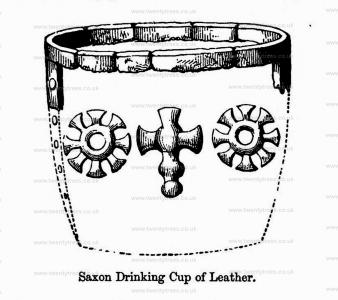

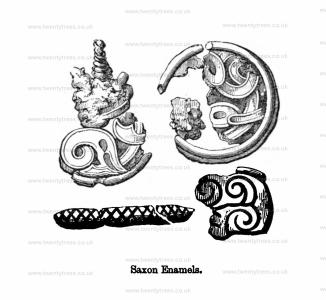
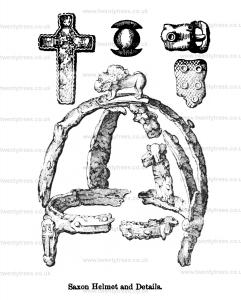
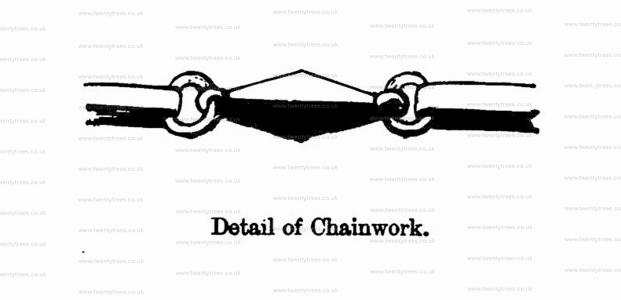




Waggon Low. On the 25th of June, we proceeded to the top of a hill near High Needham, called Waggon Low [Map], where we found some indications of an artificial mound, the dimensions of which could not be ascertained, on account of the numerous rocky protuberances around it. By excavation, we found that several interments had been placed between the masses of rock, which had originally been covered by the mound. The first discovered lay on its left side upon the rock, at the South side of the barrow, at the depth of about eighteen inches from the surface, with the knees drawn up, and the head towards the S.W.; immediately in front of this skeleton were two iron knives, respectively 5¼ and 8⅛ inches long, lying in contact with each other; there were also several tips broken from the tines of stags horns, some other imperfect animal bones, and part of a quern, which had been used as a sharpening stone, in the vicinity of the skeleton, which was that of an aged person, one of whose legs had been fractured, and reunited immediately above the ankle. Pursuing the excavation towards the north, the rock was found to have been cut out to the further depth of 18 inches, so as to form a large irregularly shaped grave; at the end nearest the first discovered skeleton, there was a large stone, under which was a deposit of calcined bones, accompanied by a small arrow-point of flint, and a rude instrument of bone, and in an angle of the rock close by, was a small vase of coarse clay, slightly ornamented, 4½ inches high. Next to this deposit were the bones of a full-grown person and an infant, both much decayed, but we considered the former to have been laid with the head to the east, they were destitute of relics, and were very imperfect, though they did not appear to have been disturbed. Immediately in contact with them, we observed the feet of another skeleton, which being carefully uncovered, was seen to lie on its right side, with the legs gathered up, and the skull to the north; at the right shoulder were three instruments of light-coloured flint and a small bronze awl, 1½ inch long, tapering each way from the middle, which is square - also the leg bone of a dog. The skeleton is that of a young person slightly above the middle height, the jaws containing the full number of teeth, which are but little worn; it is in beautiful preservation, and having been articulated, is preserved in a glass case at Lomberdale [Map]. Two flat stones were set up on edge behind it in the barrow, and it was imbedded in earth, to which it owed its preservation. During the progress of these researches, we observed the ground at the west side of the trench to have been disturbed yet lower, but were unable to follow up the indication, from the approach of evening; therefore, on the 28th of June, we again visited the spot, and after removing stone to the depth of 4 feet 6 inches, found that the grave assumed the shape of the letter L the lower limb representing the western portion, now under examination, where we discovered the skeleton of a good sized man of middle age, lying on his left side with the knees drawn up, and the head towards the west, embedded in tenacious clay, above which was a thick layer of charcoal. The whole grave was carefully cleared out to its extremest limits without further result, except the discovery of numerous rats' bones, and of occasional portions of those of larger quadrupeds, such as horses' and swine's teeth.
 Bateman's original notebook on display at Weston Park Museum, Sheffield.
Bateman's original notebook on display at Weston Park Museum, Sheffield.
Harold Gray 1902. On the south-east, adjoining the external face of the vallum and partly resting on it, a tumulus [Map] stands, the summit 7½ feet above the surrounding turf-level (see photograph, plate II.). This barrow was first attacked in 1770 by the then occupier of the farm, without success. Likewise to 1782 by Major Rooke, assisted by John Manders, and in 1824 by William Bateman and Samuel Mitchell, of Sheffield. A fourth attempt, made in 1845, by Thomas Bateman and Rev. S. Isaacson, resulted in the discovery of a limestone cist, which has been frequently described1. It contained calcined human bones, a bone pin2, pyrites and flint, and two small urns3, differing considerably in style and ornamentation, but undoubtedly of Bronze Age manufacture, and probably rather early in that period4.
Note 1. "Arbor Low," by Sir John Lubbock, the Reliquary, xx. 8l-85; Bateman's Vestiges of the Antiquities of Derbyshire, 64-66 and 74; and Winchester Volume of the British Archrological Association (1845), 197-204.
Note 2. Figured in Fergusson's Rude Stone Monuments, r4r, and Vestiges, 65,
Note 3. These relics are in the Sheffield Museum. The urns are reproduced by kind permission of Mr. E. Howarth, the curator.
Note 4. Dr. Brushfield calls my attention to the very misleading representation of this urn in Vestiges of the Antiquities of Derbyshire, p. 65.-Ed. D.A.N.E S
